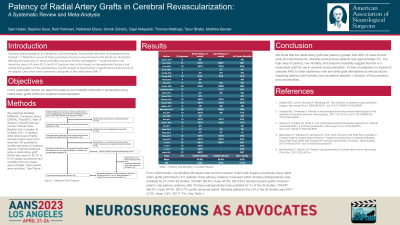Patency of Radial Artery Grafts in Cerebral Revascularization: A Systematic Review and Meta-Analysis
Patency of Radial Artery Grafts in Cerebral Revascularization: A Systematic Review and Meta-analysis
Friday, April 21, 2023


Sam J. Haber (he/him/his)
Medical Student
University of Rochester School of Medicine and Dentistry
ePoster Presenter(s)
Introduction: Cerebral revascularization, its indications, and techniques, has evolved since first its development by Yasargil. While the success of these procedures has been documented in the literature, the factors affecting the outcomes of these procedure warrants further investigation. In this systematic review, we report the patency and mortality observed in procedures using radial artery grafts (RAG) for cerebral revascularization.
Methods: We searched PubMed, EMBASE, Cochrane Library, CINAHL, PsycINFO, Web of Science, ClinicalTrials.gov, and EU Clinical Trials Register from inception to October 2021. In addition, cited references of highly relevant papers were hand searched. All quantitative studies reporting n>1 patency data for a defined timepoint when a RAG was used for EC-IC or IC-IC bypass procedures and mortality from any cause were included. Case reports were excluded.
Results: Of 2,649 reports, we identified 26 papers that met the inclusion criteria with bypass procedures using radial artery grafts performed in 375 patients. Early patency (patency measured within 30 days postoperatively) was available for 24 of the 26 studies. 253/263 (96.2%; mean 94.8%; SD 9.4%) reported bypass grafts remained patent. Late patency (patency after 30 days postoperatively) was available for 17 of the 26 studies. 161/172 (93.6%, mean 93.1%, SD 10.4%) grafts remained patent. Mortality gathered from 26 of the 26 studies was 8/375 (2.1%, mean 4.1%, SD 12.3%).
Conclusion : We found that the radial artery graft was patent in greater than 93% of cases at both early and late timepoints. Mortality among these patients was approximately 2%. The high rates of patency, low mortality, and anatomic feasibility suggest that this is a reasonable graft for use in cerebral revascularization. Further investigation is required to compare RAG to other saphenous vein and other graft alternatives as well as factors impacting patency and mortality such as patient selection, indication of the procedure, and comorbidities.
Methods: We searched PubMed, EMBASE, Cochrane Library, CINAHL, PsycINFO, Web of Science, ClinicalTrials.gov, and EU Clinical Trials Register from inception to October 2021. In addition, cited references of highly relevant papers were hand searched. All quantitative studies reporting n>1 patency data for a defined timepoint when a RAG was used for EC-IC or IC-IC bypass procedures and mortality from any cause were included. Case reports were excluded.
Results: Of 2,649 reports, we identified 26 papers that met the inclusion criteria with bypass procedures using radial artery grafts performed in 375 patients. Early patency (patency measured within 30 days postoperatively) was available for 24 of the 26 studies. 253/263 (96.2%; mean 94.8%; SD 9.4%) reported bypass grafts remained patent. Late patency (patency after 30 days postoperatively) was available for 17 of the 26 studies. 161/172 (93.6%, mean 93.1%, SD 10.4%) grafts remained patent. Mortality gathered from 26 of the 26 studies was 8/375 (2.1%, mean 4.1%, SD 12.3%).
Conclusion : We found that the radial artery graft was patent in greater than 93% of cases at both early and late timepoints. Mortality among these patients was approximately 2%. The high rates of patency, low mortality, and anatomic feasibility suggest that this is a reasonable graft for use in cerebral revascularization. Further investigation is required to compare RAG to other saphenous vein and other graft alternatives as well as factors impacting patency and mortality such as patient selection, indication of the procedure, and comorbidities.
